Moist Vanilla Cake
This post may contain affiliate links. Read the full disclosure here.
This moist vanilla cake recipe is supremely soft with loads of vanilla flavor. It’s covered in a silky vanilla buttercream frosting that isn’t overly sweet! I can guarantee this will be the best cake you’ve ever had.
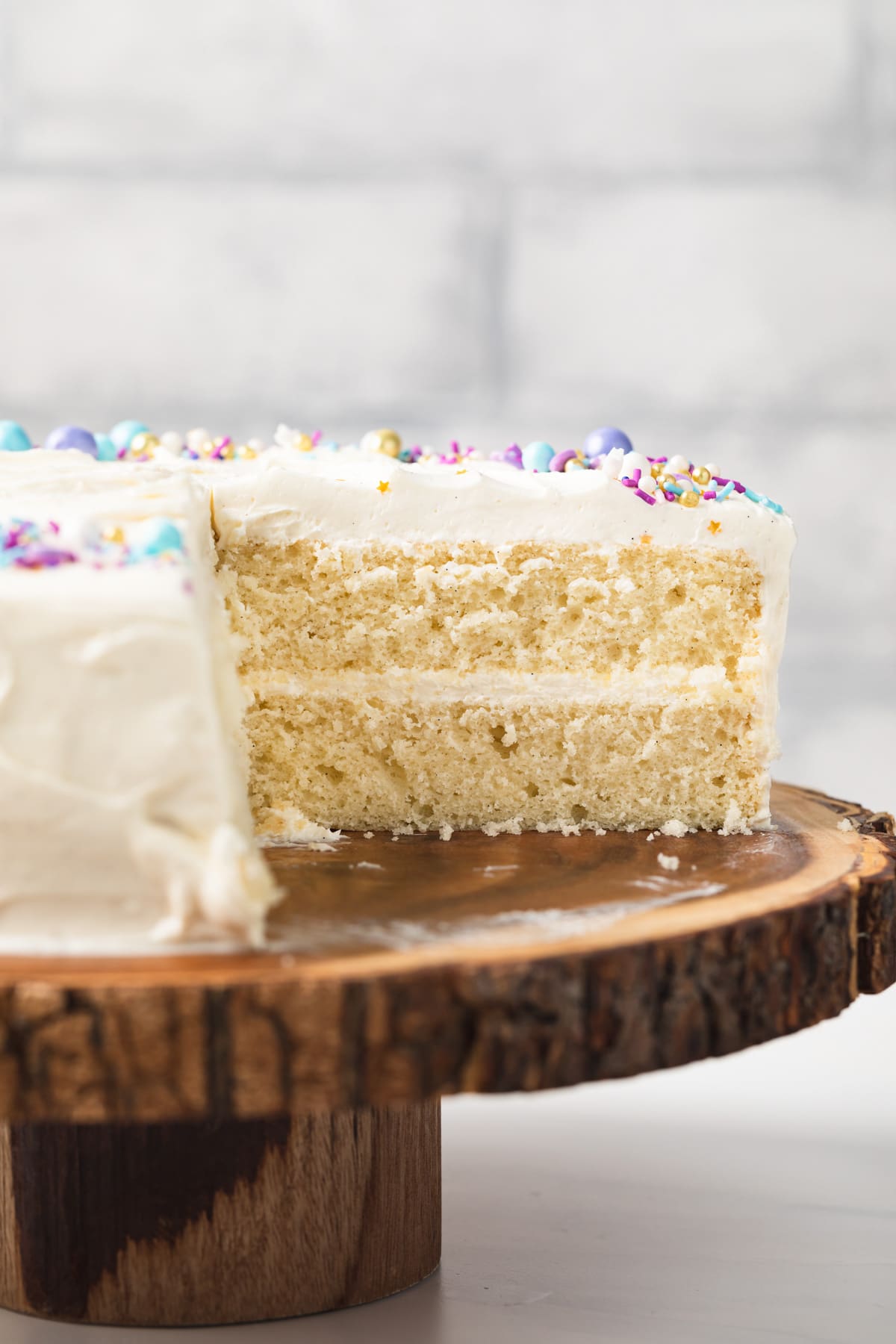
Vanilla cakes may seem so basic but when done right, they’re better than any other cake out there. And they are perfect as birthday cakes because everyone likes vanilla. You just can’t go wrong with serving one at your next party.
Today’s moist vanilla cake is so perfect, you’ll be going back for a second slice. It has a soft and supple crumb that is so far from dry, it will stick to your fork.
It’s also not a very sweet cake, even with the frosting. It sort of feels light and airy. You can easily eat a large slice without feeling like you devoured spoonfuls of straight sugar.
It’s truly the best vanilla cake I’ve made yet. There are a few in various forms like cakes and cupcakes. I’m pretty certain you will agree once you give this one a try.
The vanilla frosting is nothing more than my Swiss meringue buttercream. I tested it with vanilla bean paste because that’s what I used to flavor the cake and loved the result.
The only downfall is the frosting will have little specks of vanilla throughout. This can be undesirable depending on how you wish to decorate it. But the flavor was spot on.
I kept it simple with swoopy swirls for a rustic look then decorated the top with some pretty sprinkles. Feel free to get creative with it!
You may also really enjoy my fluffy yellow cake. And for something less sweet, try my Irish tea cake.
Why this recipe works
- Equal amounts of oil and butter go into the cake for the very best texture. Don’t veer from this or the cake will not be as good as intended.
- Using vanilla bean paste in the cake really gives the purest vanilla flavor without being too potent. I highly recommend it!
- Cake flour provides a tight crumb that is pillowy soft. Don’t use anything other than cake flour, not even homemade cake flour. The results will not be the same.
- Buttermilk is crucial! Whole milk and milk alternatives will not provide the same results.
- Using bake-even strips provides even baking with level cake layers. They also help the cake retain moisture during baking!!
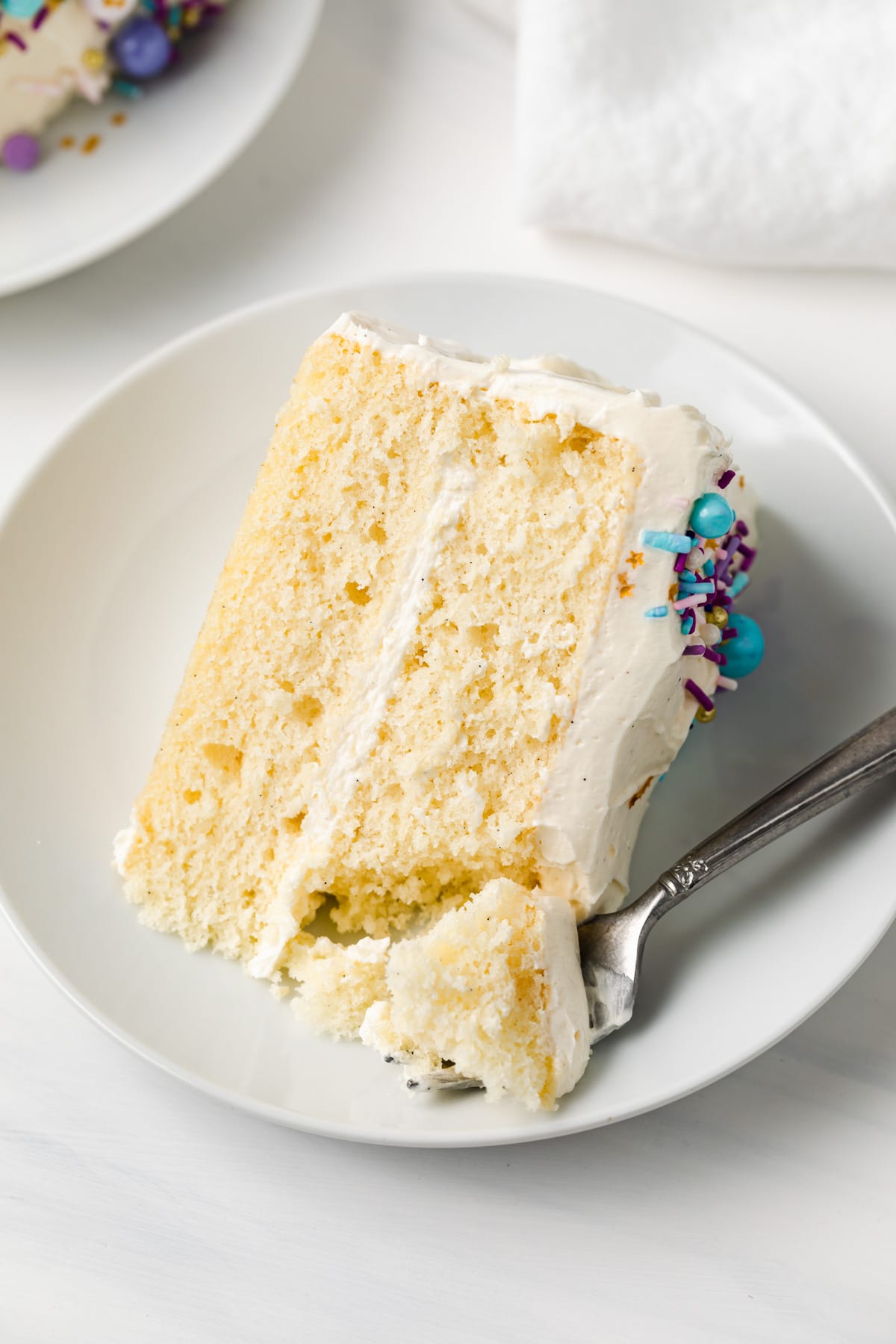
Moist Vanilla Cake Recipe
I’m truly obsessed with developing the very best cake recipes. Over the years I’ve filled the archives with cakes that continuously get rave reviews.
Today’s cake is probably the best one yet and just may become the base recipe for all my cakes going forward. The feedback from my taste testers has been nothing but positive.
I adore how subtle the sweetness is and the vanilla is truly the highlight.
The vanilla cake batter yields a texture that is beyond amazing. It’s soft yet sturdy enough for tiered cakes or even shaped cakes. It also holds up under fondant.
It’s truly so versatile, you can do so much with it. It’s incredible for cupcakes!
It also makes a great base flavoring. I used the same recipe for my lemon cake but added lemon juice and zest to the batter. It came out phenomenal!
Moist vanilla cake ingredients
You’ll recognize all the ingredients below. Each one plays a key role in the success of the final product. Don’t substitute any ingredient, otherwise, you jeopardize the integrity of the recipe.
- Oil: I highly recommend canola or vegetable oil but any flavorless oil will work. The oil plays an important role in the cake’s moisture.
- Butter: The butter adds a slight richness and moistness to the cake. Use unsalted butter so you can control the amount of salt that goes into the recipe.
- Sugar: Granulated white sugar is the only sugar I recommend for a successful cake. It adds sweetness and aids in keeping the cake moist.
- Eggs: The eggs provide structure. They help hold the cake together. They’re also a fat, which also adds to the moisture.
- Vanilla: I strongly recommend using vanilla bean paste. The flavor is unmatched.
- Flour: Cake flour is the only flour I suggest. Its low protein content will prevent too much gluten from developing and in turn yields the softest, tenderest texture.
- Baking powder: Baking powder is used for leavening. Look for one that is aluminum-free. Baking powders that contain aluminum will sometimes have a metallic taste.
- Salt: Regular table salt is all I typically use for baking.
- Buttermilk: Buttermilk is essential to the cake’s texture. Whole milk or any milk alternatives will not provide the same results.
To make this vanilla cake you’ll need:
- 9-inch round pans: Use aluminum baking pans! These pans allow the batter to “climb” the walls of the pan so the layers bake up tall. Avoid any and all pans that are nonstick when baking cakes!!
- Bake-even strips: I swear by bake-even strips. They are cloth strips that you soak in water and wrap around the cake pans. They promote even cooking so the layers bake up moist and level.
- Mixer: I always use a stand mixer with a paddle attachment.
How to make a super moist vanilla cake
There are a few key techniques that will help produce the very best vanilla cake ever! Be sure to follow my recipe closely and avoid common mishaps.
The Batter – The batter is thick and mousse-like in texture. I prefer cake batters this way as I feel they bake the best.
The Frosting – The vanilla buttercream is a Swiss meringue frosting. It’s much less sweet than American buttercream.
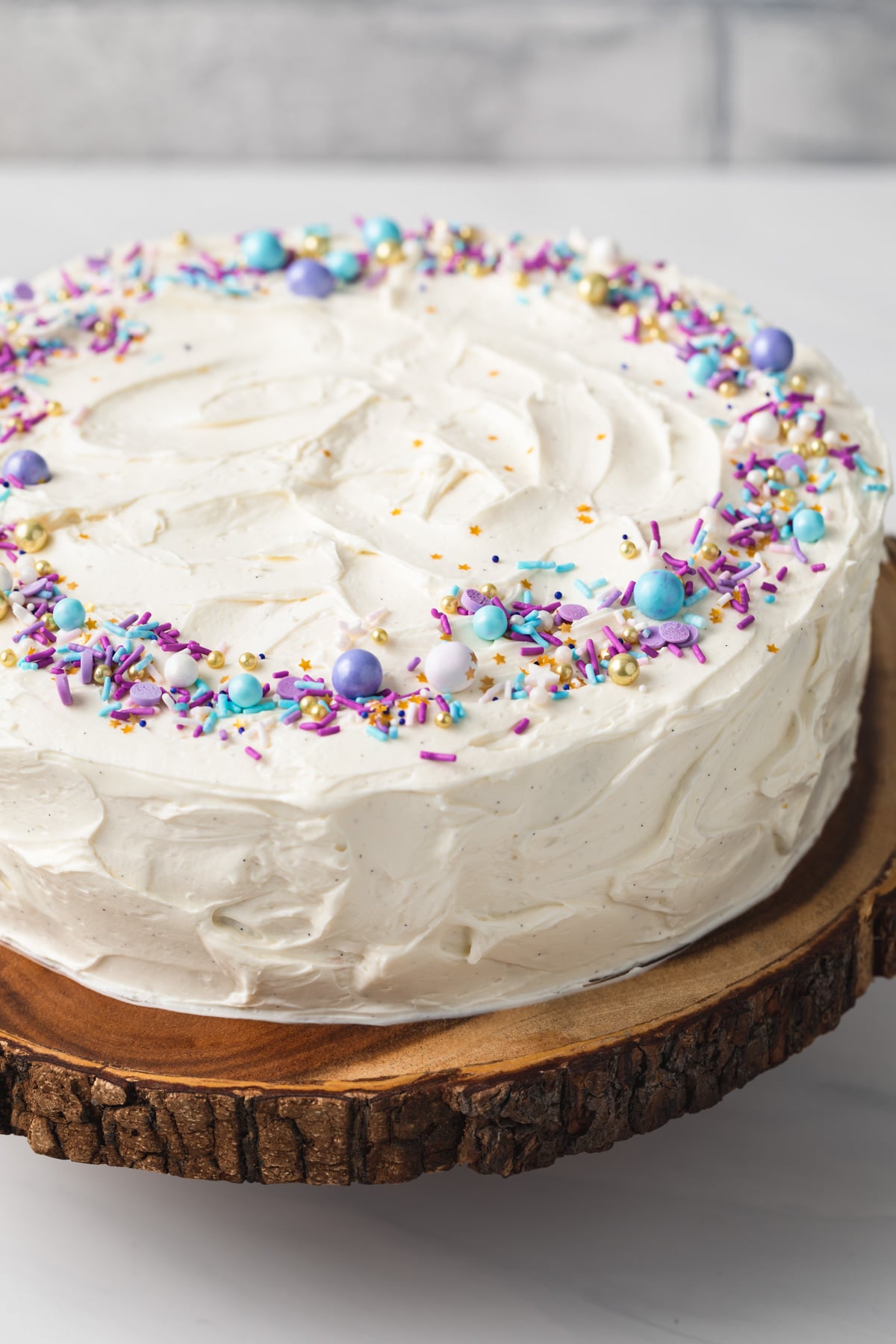
Step 1: Make the batter
Before you make the batter, make sure all the cold ingredients have been brought to room temperature. This is vital for getting the ingredients to emulsify properly. Mixing room temperature ingredients with cold ingredients will cause the batter to curdle.
Next preheat the oven for about 30 minutes before you plan to make the cake. This will ensure the oven is up to temperature.
When it comes to mixing the ingredients for the batter, mix the oil, butter, and sugar together for a full 5 minutes. This aerates the mixture which helps produce a light, fluffy cake texture.
Beat in the eggs one at a time, allowing each one to incorporate before adding the next one. Then, beat in the vanilla.
Sift or whisk the flour, baking powder, and salt together. I like sifting because this aerates the flour, removes clumps, and ensures the baking powder is evenly distributed.
Add half the flour mixture to the butter mixture and mix until almost fully combined. Then mix in all the buttermilk. Finally, mix in the remaining flour.
Don’t over mix here. You only want to mix just until no streaks of dry flour are visible. Overmixing will ruin the texture of the cake.
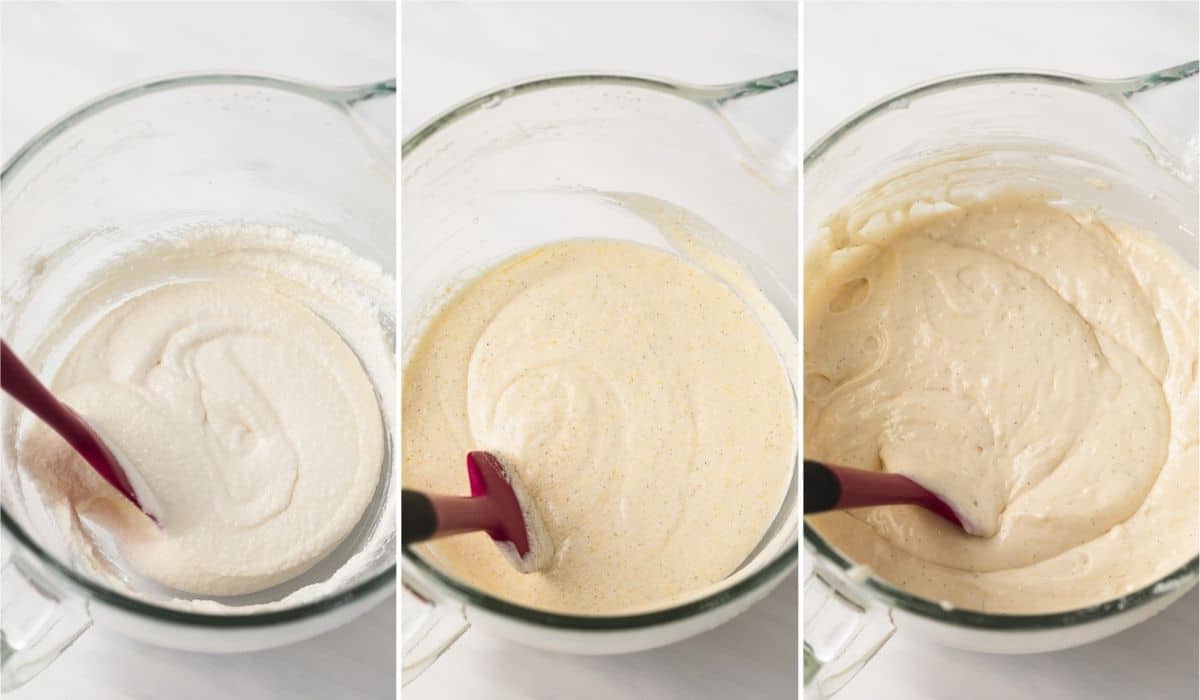
Step 2: Bake the cake
Divide the vanilla cake batter evenly between two 9-inch round cake pans.
The pans should be well greased and lined with parchment paper cut to fit the bottom. Use bake-even strips around the pans for even baking.
Bake for 20-25 minutes or until a toothpick inserted into the center comes out with only a few moist crumbs attached. You don’t want the toothpick to be completely clean because that means the cake is overbaked and will be dry.
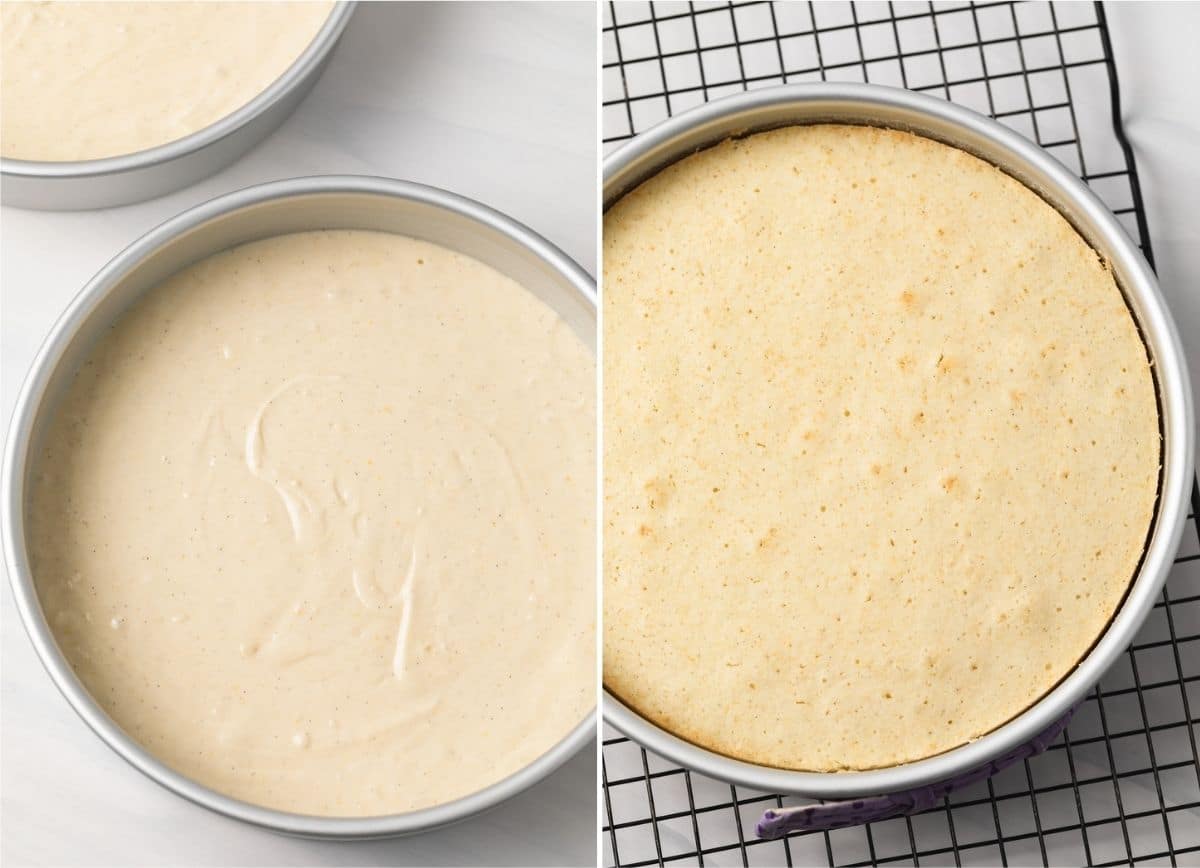
How to frost a layer cake
Place the first layer upright on a cake stand or serving platter. Spread ⅓ of the frosting over the top of the layer. The vanilla buttercream in the recipe below yields 4 cups of frosting.
Instead of measuring it out, I smooth the frosting evenly in the bottom of the mixing bowl. Then I use a spatula to divide it into 3 equal portions. Fewer dishes to mess up and it doesn’t have to be 100% precise.
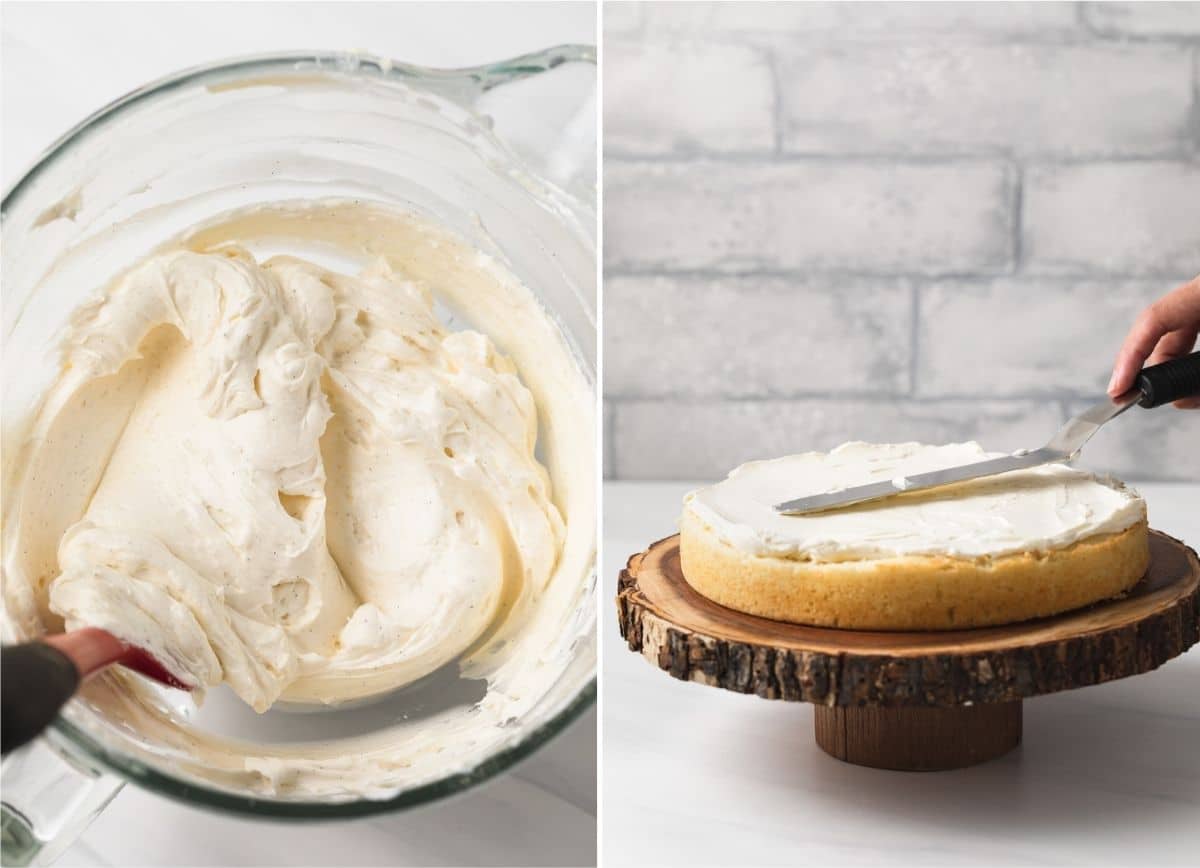
Place the top layer bottom side up over the frosted bottom layer. Use ⅓ of the frosting to cover the top of that layer. Finally, use the remaining ⅓ to cover the sides of the entire cake.
Swoop the frosting like I did, or use a cake scraper to smooth it out. If you wish to pipe designs on the cake, you’ll need to increase the recipe by 1.5 times. The recipe as is makes just enough frosting to cover the cake.
I opted to keep it simple and added a few fancy sprinkles to the top.
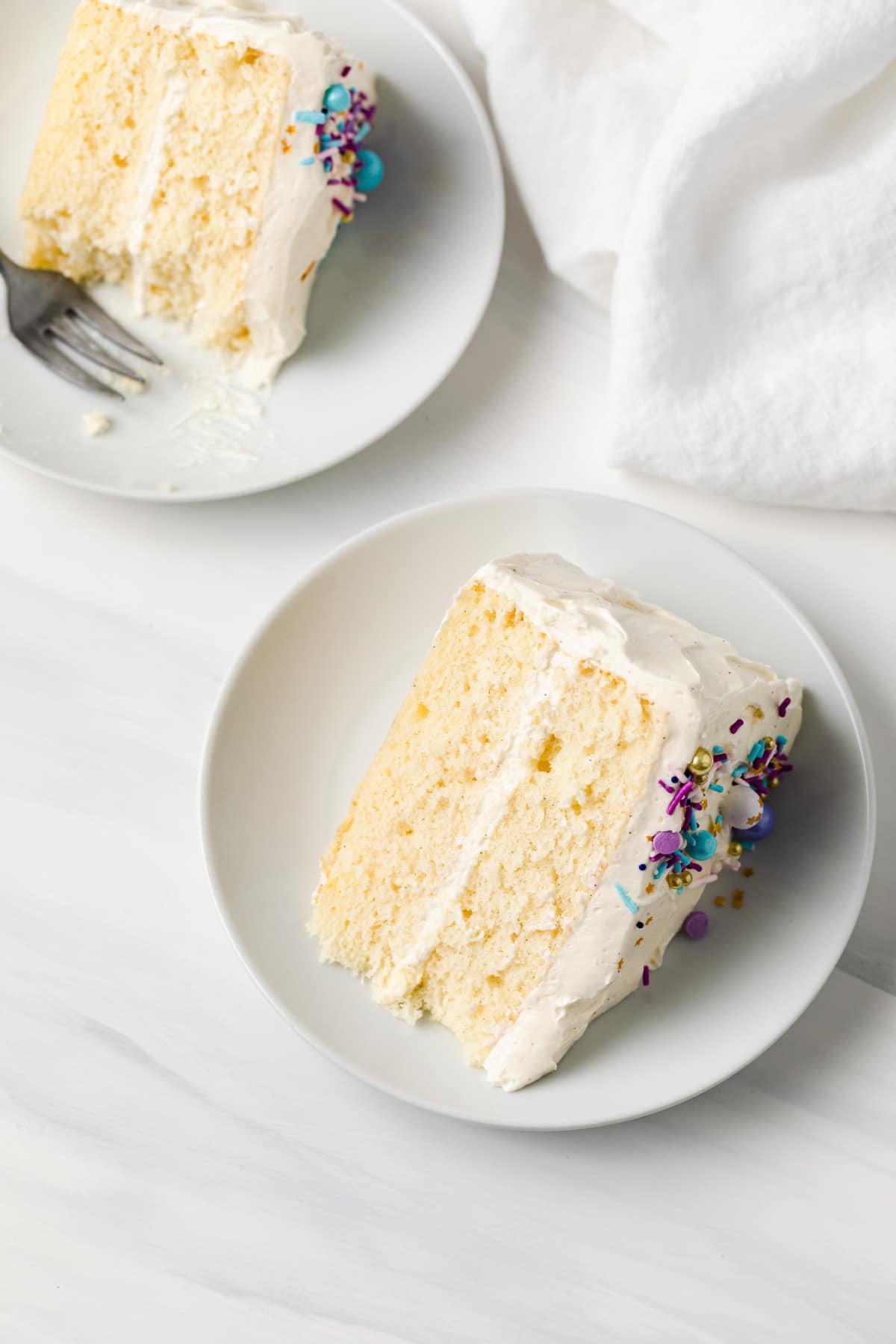
Tips for success
- Weigh the ingredients. Gram measurements are included in the recipe. This will give you the most accurate measurements. Small kitchen scales are relatively inexpensive.
- Use room temperature ingredients. The ingredients mix together easily when they are all the same temperature. Cold ingredients will cause the batter to curdle and increase the chance of over mixing.
- Don’t substitute ingredients! Use the exact ingredients called for in the recipe. This is how the recipe was developed and tested. I can not guarantee the success of the final product if you veer from the recipe.
- Don’t frost warm cake layers!! I think this goes without saying, but warm cake layers will melt the frosting. Allow time for the layers to cool completely before frosting. I’ll leave tips in the recipe notes for how to prep the layers for frosting the next day if needed.
- Serve the frosted cake at room temperature. Room temperature cakes are softer and the frosting is silkier. While the cake slices best when cold, the frosting can crack and crumble. Also, cold cakes can taste a bit drier than a cake that’s never been refrigerated.
If you like this moist vanilla cake, you’ll love these other tasty cake recipes:
Moist Vanilla Cake
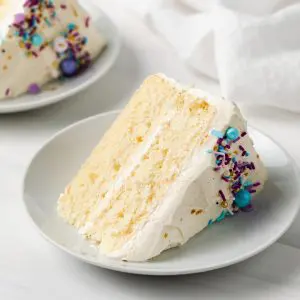
Ingredients
For the cake
- ½ cup (120 ml) canola oil, or vegetable oil
- ½ cup (113 g) unsalted butter, room temperature
- 1 ½ cups (300 g) granulated sugar
- 4 large eggs, room temperature
- 1 tablespoon vanilla bean paste
- 3 cups (360 g) cake flour
- 1 tablespoon baking powder
- ½ teaspoon salt
- 1 cup (240 ml) buttermilk, room temperature
For the frosting
- 1 cup (200 g) granulated sugar
- 5 large egg whites
- ¼ teaspoon salt
- 2 cups (452 g) unsalted butter, cut into pieces at room temperature
- 1 tablespoon vanilla bean paste, or vanilla extract
Instructions
Make the cake
- Preheat the oven to 350°F. Grease the inside bottom and sides of two 9-inch round pans. Line the bottom of the pans with parchment paper cut to fit. Lightly grease the parchment paper. Dust the inside bottom and sides of the pan with flour, then tap out any excess. Wrap the pans in wet bake-even strips. Set aside.
- In a large bowl, beat the oil, butter, and sugar together on medium-high speed until light and fluffy, about 5 minutes. Add the eggs, one at a time, mixing for 20 seconds after each addition. Beat in the vanilla.
- Combine the flour, baking powder, and salt in a medium bowl. Stir with a whisk and add half to the butter mixture. Beat on low speed until the flour is almost fully incorporated. Mix in the buttermilk, followed by the remaining flour mixture, and beat on low until just combined. Take care not to over mix.
- Divide the batter evenly between the prepared pans and bake for 20-25 minutes, until a toothpick inserted into the center comes out with only a few moist crumbs attached.
- Cool in the pans for 10 minutes then transfer to a wire rack and allow to cool completely before frosting.
Make the frosting
- Combine the sugar, egg whites, and salt in the bowl of a stand mixer. Set the bowl over a saucepan filled with 1 inch of barely simmering water. Whisk gently and continuously while heating the mixture. It should register 150°F on an instant-read thermometer. The sugar should be fully dissolved.
- Transfer the bowl to the stand mixer and fit it with the whisk attachment. Beat on medium speed until the mixture is the consistency of shaving cream and cooled slightly, 1-2 minutes. (if the meringue is warm, it will melt the butter.)
- Gradually add the butter, 1 tablespoon at a time, until smooth and creamy. (Only add the next tablespoon of butter once the last one has been completely mixed in.)
- Once all the butter is added, scrape down the sides of the bowl and mix on medium-high and beat until light and fluffy, about 30 seconds.
- Add the vanilla paste and continue to mix on medium-high until incorporated.
- Frost the cake as desired.
Notes
- Oil is important for this recipe because it adds moisture. Canola or vegetable oil work best.
- Vanilla bean paste is preferred but you can use pure vanilla extract. Homemade vanilla extract is also a great alternative. If using vanilla bean paste in the frosting, keep in mind you will see the flecks of vanilla throughout the frosting.
- Avoid substituting ingredients in this recipe. I can not guarantee the results if you use any ingredient other than what is listed.
- Using bake-even strips will allow more moisture to be retained in the cake layers. They also promote even baking so the layers are level. This eliminates the need to trim so much cake off the tops.
- Wrap baked and cooled cake layers tightly in plastic wrap and store them in the refrigerator. Assemble and frost the cake within 2 days.
- Or layers can be triple wrapped in plastic wrap and frozen for up to 2 weeks. Leave wrapped and set on the counter to thaw slightly before assembling and frosting.
- The frosting can be made 1 day in advance. Store in the refrigerator in an airtight container. You must let the buttercream come to room temperature by setting it out on the counter for a couple of hours, then beat it with an electric mixer before using.
- Once the cake has been assembled, cover it and keep it at room temperature for up to 3 days. Or store it in the refrigerator for up to 5 days. Bring it to room temperature just before serving.
- The frosted cake can be frozen for up to 2 months. Thaw it overnight in the refrigerator and let it come to room temperature just before serving.
Nutrition
The nutrition information provided is for convenience and as a courtesy only. It is not guaranteed to be accurate because nutrition information can vary for a variety of reasons. For precise nutritional data use your preferred nutrition calculator and input the exact ingredients and brands you used in the recipe.

why can’t I see the gram measurements anymore?
I’m so sorry about that! It was an error on our part with the new site design. Thank you for bringing it to my attention. It is now fixed.
This is unequivocally the best cake… even better than your basic vanilla cake. I didn’t receive a single critique from my family. I received so much praise with every bite that I started to feel uncomfortable. So thank you for the amazing recipe.
By the way I used margarine instead of butter and the cake was still fantastic.
Will this cake work with a chocolate frosting instead of vanilla? Do you have any suggestions for what kind of chocolate frosting to use?
You can use any frosting you prefer with vanilla cake layers. I have a chocolate swill meringue buttercream and a chocolate American buttercream. I like the swiss meringue because it’s not as sweet.